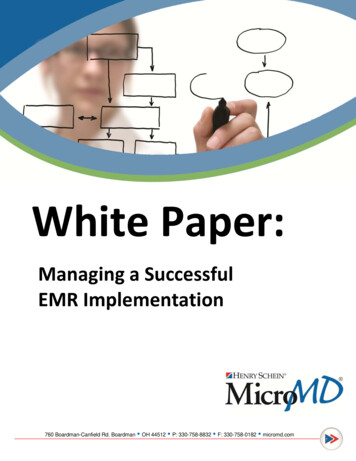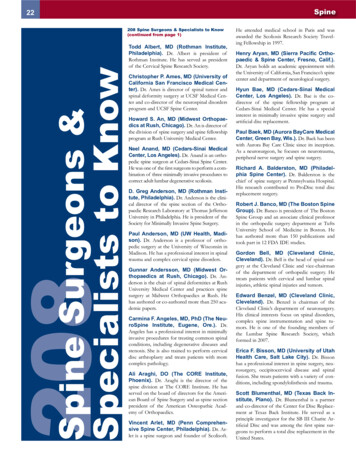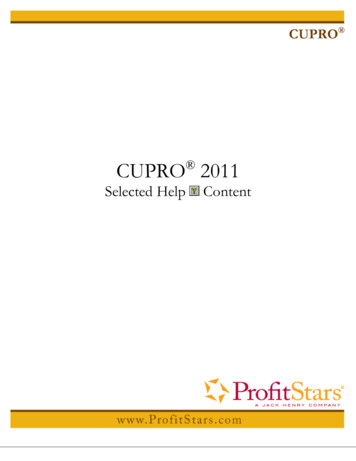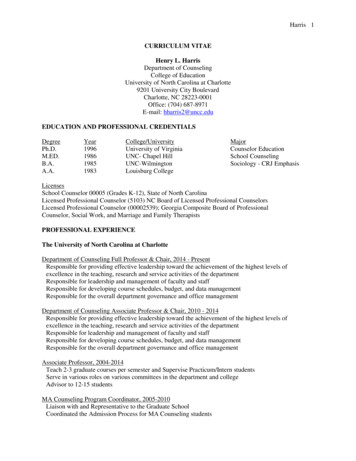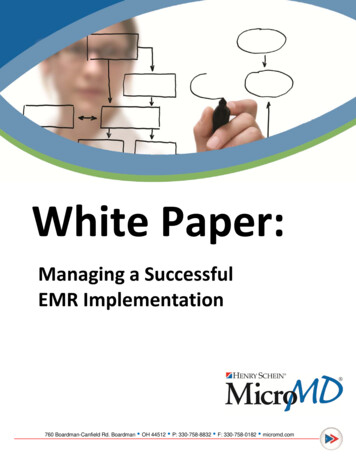
Transcription
White Paper:Managing a SuccessfulEMR Implementation760 Boardman-Canfield Rd. Boardman OH 44512 P: 330-758-8832 F: 330-758-0182 micromd.com1
Table of ContentsIntroductionPage 3EMR Implementation OverviewPage 3ExpectationsPage 3Goals and ObjectivesImplementation TimelinellPhased ImplementationConceptsPage 5-Phased Application Implementation-Phased Usage ImplementationPage 6Page 8Page 9Page 9HL7 InterfacesPage 9Workflow AnalysisPage 10Implementation Project DeliverablesPage 15-Hardware InstallationPage 15-Software InstallationPage 15-Scanning Paper ChartsPage 16-Interfaces (Lab, PM, Devices etc.)Page 17-ePrescribingSet upPage 18-EMR ConversionsPage 18-Database SetupPage 18-Customizations (clinical vs. workflow)Page 18-PM Demographic Data DumpPage 19-Software TrainingPage 19The Perpetual ImplementationPage 20A Parting WordPage 21760 Boardman-Canfield Rd. Boardman OH 44512 P: 330-758-8832 F: 330-758-0182 micromd.com2
White Paper Objective: Help for the EMR ChampionsNotes:The objective of this white paper is to help Electronic Medical Record (EMR)implementation champions understand the complexities of the EMR implementationprocess. In other words, this information is intended to help the heroes who face thedaunting task of transforming the intricate processes of a physician practice from paper toelectronic. We hope that this information will help you define goals and objectives, as wellas implementation project deliverables, milestones and timing that will help yousuccessfully implement EMR that is fully adopted and utilized by your intended users.EMR Implementation Overview: Major SectionsExpectations: this section is designed to help the reader understand the importance ofproper expectations within the practice and also contains some points on re‐engineeringimproper expectations.Goals and Objectives: this section is designed to help the reader understand the practiceperspective regarding their decision to purchase the EMR and what the practice is trying toget out of the system.Implementation Timeline: this section is designed to help the reader understand thecomplexity of the EMR implementation timeline and to help guide the reader to create aneffective and accurate implementation timeline.Phased Implementation Concepts: this section touches on two different concepts that canbe used to help practices adopt the EMR and slowly transition from the paper workflowmodel to the electronic workflow.HL7 Interfaces: this section contains information and recommendations regarding HL7interfaces. Getting these interfaces working effectively in the EMR takes time, persistenceand a basic level of HL7 understanding to communicate effectively between your vendorlaboratory partners, should any issues arise.Implementation Project Deliverables: this section contains information and suggestionsregarding each deliverable in the implementation timeline. By reading through this sectionyou will be able to understand each deliverable to determine how it can affect the overallimplementation timeline.The Perpetual Implementation: this section reinforces the need to have constantcommunication with the practice during the implementation and after they initially go livewith the EMR. This section offers some suggestions in relation to the PhasedImplementation Concepts. By employing the concepts of the perpetual implementationyou will help the practice obtain a total solution.760 Boardman-Canfield Rd. Boardman OH 44512 P: 330-758-8832 F: 330-758-0182 micromd.com3
ExpectationsEnsuring that a practice has proper expectations will determine the successfulness of theEMR implementation. If a practice has expectations that are different from theimplementer, sooner or later the implementation will go astray from the practice’sexpectations, which could lead to low adoption rates or underutilization. The objective ofthe implementer is to have the practice successfully adopt the EMR and help them toachieve their goals for EMR implementation and ongoing use.Why practices choose to implement EMRThere are four main reasons practices choose to use electronic medical record solutions.1.2.3.4.To improve patient careTo ensure patient safetyTo improve the clinical efficiency of the practiceTo improve the financial results of the practiceDefining the goals of your practice will help you to understand the implementation timelineand scope and will ensure that you are working towards the needs of the practice.Interviewing different people in the practice will help unite staff members and assist ingathering this information (see the section titled Workflow Analysis).How practice expectations are createdThe practice will develop expectations of the EMR system during the sales process. TheEMR salesperson will have the opportunity to set proper expectations about the capabilitiesof the application. During any software demonstration is it critical for the salesperson tounderstand the needs and goals of the practice and develop proper expectations with theclient with regards to timeframe, ease of deployment and adoption, and timeframes.Setting realistic expectations during the sales process will help to create a seamlesstransition between the sales and implementation processes.Some examples of unrealistic expectationsA practice may wish to implement the software faster than it can reasonably beimplemented. A successful implementation takes time and requires thorough investigationinto the workflow of the practice. Implementing an EMR solution is not an “out of the box”solution. Some practices may feel that they should be able to install the application andimmediately start to use it.A practice may feel that it doesn’t need the requisite amount of training to be successful. Apractice might have three providers, but is trying to save money by only purchasing alimited training package from their vendor. The reality is, some providers may prefer one‐on‐one training, instead of “classroom” style training, and this may lead to more requireddays of training to budget for with the vendor.A busy provider may feel they don’t need software training. They may believe that they willstart using the system and that it will automatically do what they need it to “out of thebox”. This is an example of an expectation that should be clarified early on as well.760 Boardman-Canfield Rd. Boardman OH 44512 P: 330-758-8832 F: 330-758-0182 micromd.com4
What can happen if unrealistic expectations are set?EMR implementations can be complex and it is important that a practice understands thelevel of change that will be required when the EMR is deployed and is used in a liveenvironment. Buy‐in to changes is best obtained when the leadership within a practice isspearheading the change for the rest of the staff.A practice may want an EMR solution solely for the purpose of document management.The only need they may have is for an electronic storage repository for the paper charts andincoming paper via mail and fax. While the practice may have acquired an application thatdoes much more for them than only storing documents, it is important to help themachieve their goals without bias. It is also important to assess the needs of the practice andmake appropriate recommendations with regards to adopting more capabilities of the EMRto improve practice efficiency and effectiveness.EXAMPLE:Let’s use the example that the provider doesn’t want to schedule time away from patientsto attend a lengthy training session on the new EMR. The practice purchased 5 days oftraining but the provider informs you that he/sheshe will not be available one of the fivedays because of surgery and will only be available between scheduled patients theremaining four days.When you inquire about this, the office manager explains that the provider is too busy toschedule time away from the patients and that the practice needs the revenue. Theprovider has explained that she will pick it up in the evenings and that she will have theoffice manager attend training work with the provider as needed.If the provider does not adopt the EMR then the practice risks failure with the EMR. If theprovider doesn’t get the needed training to be successful then he/she will get frustrated.Left unresolved, the provider will not realize a return on investment and wonder why any ofthe effort was worth it.SOLUTION:To solve this issue, the implementer needs show sensitivity to the situation byunderstanding the concerns of the provider and practice. Does the implementerunderstand how much money is being lost by attending training as opposed to seeingpatients? Does the implementer understand the commitment level the provider hastowards patients? Does the provider offer alternative flexible times for training, outside oftraditional open office hours?To create a proper expectation with the provider, the implementer will need to draw on thegoals of the provider. Consider that the two main goals of the provider are to make moremoney and to improve the quality of care that each patient receives. Using this informationthe implementer can show the provider that he/she understands the needs and goals of theprovider. A conversation to help the provider understand that, by committing to be presentduring training, he/she will actually be investing in a tool that will enhance the patient careexperience, while reinforcing optimal documentation and revenue capture. The vendorrepresentative benefits from emphasizing the vendor’s personal success with prior clientsthat were prepared, invested and committed to the phases of change that occur during the760 Boardman-Canfield Rd. Boardman OH 44512 P: 330-758-8832 F: 330-758-0182 micromd.com5
initial adoption phase of EMR. As with any new investment, there is a learning curve thatshould be approached aggressively in the early stages.While difficult to carve out the right amount of time, time and effort is critical if the EMR isto be successfully implemented. It is best to plan for success rather than “hope for thebest” as a result. A fantastic point to return to is an analogy that most practices do not havea frame of reference on what it takes to implement an EMR successfully. Practicemanagement systems have been in deployment for much of the last 30 years, and typicallythe administrative staff manages those types of implementations. An EMR is a providertool, and so the success centers around the provider experience.Goals and Objectives – Role Based VariationsIdentifying your goals and objectives will help determine the implementation timeline. Itwill also provide you with the necessary measurements for success. Identifying the goalsand objectives early on will ensure that what your EMR vendor delivers aligns with what thepractice needs.One important thing to consider in identifying your goals is that every staff member in thepractice will have differing expectations of the system. While time consuming, it isinvaluable to understand each person’s wants and needs of the EMR. Interviewing eachstaff member is a good idea, if feasible, but a successful implementation can still becompleted by understanding a particular group’s needs. It may seem appropriate to onlyconsult the providers or office manager when gathering goals, but this has the potential ofcompromising the implementation’s success.What goals am I looking to achieve?A provider’s goals for the EMR will be starkly different than the office manager. Those goalswill be different than those of the nursing and reception staff. If you accommodate onegroup, but fail to accommodate another, then there is likely to be a disconnection in theworkflow that could jeopardize adoption. It may seem appropriate to ensure that theprovider’s goals are met, but if the nurses underutilize the system because their goalsweren’t considered, it will cause problems for the provider.A provider may have the goal of seeing more patients. It may be to document encountersmore thoroughly. They may have a goal that the EMR should help guide them through anencounter so they don’t forget something or, worse yet, do something that they are unableto bill for. It may be simply to go paperless because their competition is, or because theysee advantages to patient care and safety.Nurses have many different roles and responsibilities in a practice. Great care should betaken to understand these roles and effectively accommodate for their needs in the EMR.Nurses may have goals to prep patients more effectively for the providers. It may be tohelp them organize paper better. It may be to help decrease their day‐to‐day work volume.An office manager will likely have needs very different from the clinical staff. It is a fine artto balance the goals of the administration and the goals of the clinical staff. The goal of theoffice manager may be to reduce staff. The goal of the physician may be to reduce the760 Boardman-Canfield Rd. Boardman OH 44512 P: 330-758-8832 F: 330-758-0182 micromd.com6
reliance on paper charts. The goal of the billing manager may be to ensure proper diagnosiscoding by the providers to secure maximum billing.Whatever the goal, the responsibility of the implementation champions are to effectivelygather this information and use it to build an effective implementation plan.Implementation TimelineConstructing an effective timeline will help the practice feel comfortable with theimplementation project. It will also help both the EMR champions and the practice knowwhat the next steps are so that the project doesn’t stagnate. Understanding the goals andobjectives of the practice in conjunction with a completed workflow analysis will help tocreate an effective timeline (see the sections on Goals and Objectives and also WorkflowAnalysis).Implementation should be considered a project. Project/task management is a requisiteskill in order to successfully track and plan for an effective implementation. Projectmanagement skills will also be useful when trying to manage multiple implementations atthe same time. The implementation project has a creation date, a termination date andseveral deliverables and critical steps that must be met along the way. If animplementation lacks the appropriate project management or resources, then the projectmay lag in certain areas and end up taking longer than necessary. This will cause thepractice to lose confidence in the implementation and may jeopardize the implementation.A typical implementation for a single‐provider practice can take 60‐90 days to get all therequisite deliverables completed and be prepared for software training. For each additionalprovider, consider adding an additional 2‐3 weeks to your timeline. While it may feelimportant to implement quickly, attention to detail is critical for a successfulimplementation.A typical implementation project will consist of the following deliverables (some items maynot be typical for each project): Defining a Physician Champion/Decision maker for the practiceDefining a Clinical/Nursing Champion/Decision maker for the practiceDetailed Practice Workflow AnalysisHardware InstallationSoftware InstallationScanning Paper ChartsInterfaces (Lab, PM, Device etc.)Device Interfaces (Vitals, Cardio etc.)e‐Prescribing SetupEMR Conversion (If applicable)PM Data DumpSoftware TrainingCustomizations (Clinical and Workflow)Looking at these deliverables helps to frame the complexity of a typical implementation760 Boardman-Canfield Rd. Boardman OH 44512 P: 330-758-8832 F: 330-758-0182 micromd.com7
project. Each of the deliverables needs careful consideration and planning. Softwaretraining is an especially important deliverable in the implementation timeline. The goalsand objectives of the practice will help drive the training requirements. In order forsoftware training to be successful the actual project deliverables should be incorporatedinto the training curriculum.Understanding the relative difficulty in completing some of the deliverables will help you toplan for a successful project. For example, generally a lab interface will take 60‐90 days towork out with the vendor so that it is ready to test and deploy. Also, effectively planning forthe customizations deliverable could easily take 30‐90 days.In order to effectively plan each deliverable, take the time to understand what resourcesare available and what it will take to get each deliverable completed. Once the projecttimeline has been created, dates for each of the deliverables should be affixed and the finalproject should be submitted to the practice for approval. This will help to build confidenceand trust in the EMR champions and serve as a strong roadmap.An important concept to be considered in every EMR implementation project is riskmanagement. When putting together a timeline, an effective EMR champion should counton some deliverables talking longer than expected and having to reset unrealisticexpectations. There are several things that could derail a timeline, such as vacation, clinicalconferences, weather conditions, third party vendor promises, etc. When planning anydeliverable, ask yourself what could possibly go wrong and incorporate those potentialdelays into your timeline. Remember that successfully hitting the deliverables with a longertimeline is better than missing deliverables with a shorter timeline.Phased Implementation ConceptsThe EMR implementation will generally be replacing a paper process. Understanding thedifference between the paper process and the electronic process will help you be successfulin your implementations. When a practice replaces a Practice Management System there isgenerally little pain. This is because the concepts are similar between all practicemanagement applications. The workflow is similar and users simply have to learn the newproduct’s features and tools. This is not the case with implementing EMR for the first time.Implementing an electronic workflow solution will be completely new to the practice.A practice will not generally fully adopt an EMR on a particular go‐live date for seeing everypatient, completely documenting encounters and using every feature in the application.Initially, it will be a challenge for the practice, because it has the potential of slowing downeveryday tasks. This is a natural part of learning new software and learning a newworkflow. Defining user expectations and having an appreciation for each role in thepractice during the implementation process will help you be successful.One reason that expectations may struggle in defining the original project plan, is that apractice may feel they are not able to attend to as many patients as they were prior to thego‐live date. A successful implementation targets these issues by helping the practice easeinto the EMR while maintaining pre‐implementation patient loads. Or, conversely, thepractice may elect to sacrifice (and budget for) less patients during the initial first two760 Boardman-Canfield Rd. Boardman OH 44512 P: 330-758-8832 F: 330-758-0182 micromd.com8
weeks of going live with an EMR.A phased approach can be employed to help the practice ease into efficiently using EMR. Aphased approach is a wise choice, and the expectation of a phased approach should be setearly on in the implementation project. The objective of the phased approach is to allowthe practice to use the EMR in a limited scope while they become familiar with theapplication in a live environment and to allow them to re‐engineer their workflow in amethodic manner. There are two phased approach concepts: Phased Application ImplementationsPhased Usage ImplementationsPhased Application ImplementationsThe concept behind this implementation method is that the practice will adopt all or mostof the major features of the application initially, but in a phased approach. What this meansis that, of the total daily patient load, only a fraction of those visits will be managed in theEMR. Each practice will differ on t
6 760 Boardman-Canfield Rd. Boardman OH 44512 P: 330-758-8832 F: 330-758-0182 micromd.com initial adoption phase of EMR. A
